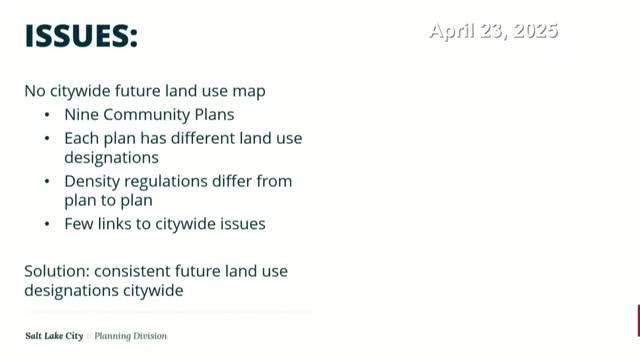Salt Lake City adds water element to Plan Salt Lake for better resource management
April 24, 2025 | Salt Lake City, Salt Lake County, Utah
Thanks to Excel Chiropractic and Scribe from Workplace AI , all articles about Utah are free for you to enjoy throughout 2025!

This article was created by AI using a video recording of the meeting. It summarizes the key points discussed, but for full details and context, please refer to the video of the full meeting. Link to Full Meeting
The session began with a discussion on the challenges posed by varying land use designations, particularly in relation to water demand projections. Officials noted that inconsistencies in density classifications—ranging from low-density areas with five dwelling units per acre to others with twelve—complicate efforts to accurately forecast water needs for future developments. To address this, the commission proposed consolidating future land use designations to ensure uniformity across the city, which is deemed essential for effective planning.
A significant outcome of the meeting was the decision to incorporate a water element into Plan Salt Lake. This addition aims to enhance the city’s vision by focusing on water-related initiatives, complying with state code requirements, and building upon existing successful policies. The commission emphasized the importance of data-driven approaches to understand water usage patterns and their implications for development.
The meeting also highlighted ongoing efforts to analyze water consumption across different zoning categories, particularly single-family residential zones. A sample study of approximately 200 properties revealed that larger lots tend to consume more water. This finding aligns with observations that public awareness of water conservation fluctuates with weather patterns, as residents are more likely to conserve water during droughts compared to wetter years.
In conclusion, the Planning Commission's discussions underscored the necessity of integrating water management into urban planning to promote sustainability and efficiency in resource use. The next steps will involve further analysis of development characteristics and the establishment of regulations that encourage responsible water use across the city.
Converted from Planning Commission Meeting -- 04/23/2025 meeting on April 24, 2025
Link to Full Meeting
Comments
View full meeting
This article is based on a recent meeting—watch the full video and explore the complete transcript for deeper insights into the discussion.
View full meeting

